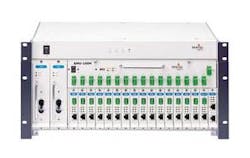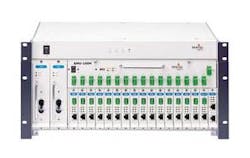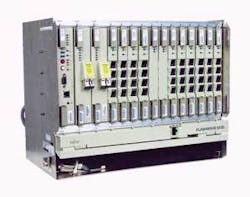Industry mulls over WDM-PON technology
To date, Korea Telecom (KT) has been the most aggressive proponent of WDM-PON, investing three million won in a WDM-PON-based FTTH deployment in Gwangju. According to the folks at Novera Optics (www.noveraoptics.com), who co-developed the network with KT, some 2,000 households in six newly constructed apartment buildings will receive services via WDM-PON technology. The new network follows KT’s successful, 100-subscriber WDM-PON-based FTTH trial, conducted in January of this year.
But KT is not the only carrier mulling over the technology. NTT also is eyeing WDM as a potential next-generation technology, according to Ryuki Yamada, NTT’s senior executive vice president. In his keynote address, “NTT’s Approach to Optical Broadband and Telecommunications Network Trends,” delivered at the Fiber Optics Expo last January in Tokyo, Yamada reportedly noted that NTT will likely deploy some flavor of WDM rather than a 10-Gbit EPON implementation.
Representatives from Verizon Business (www.verizonbusiness.com), formerly MCI, have confirmed their interest in WDM-PON technology as well, albeit for commercial service delivery. The carrier is currently conducting an R&D program to develop WDM-PON components, including semiconductor optical amplifiers (SOAs), to reduce the component count at both the customer location and headend, reports Glenn Wellbrock, director of advanced network technology.
For Verizon Business, the real benefit of WDM-PON is its extended reach capabilities. A WDM-PON architecture would enable the carrier to eliminate aggregation sites between the central office and customer location, resulting in real cost savings, says Wellbrock, who expects to conduct proof-of-concept tests in a year or so. He admits that WDM-PON technology will take several years to mature, but says, “I do think it’s the right thing going forward.”
For now, the biggest hurdle for WDM-PON is not technical but economic. True WDM-PON delivers a single wavelength both upstream and downstream to a single home or office, a feat that can be accomplished today using wavelength-specific distributed feedback (DFB) lasers or narrowband tunable lasers. However, it’s simply cost prohibitive to locate a DFB laser at every residence, admits Randy Eisenach, market development manager for Fujitsu Network Communications’ Access Division (http://us.fujitsu.com/telecom). “You just can’t have an ONT [optical network terminal] at the side of the house that costs multi-thousands of dollars when service providers are looking at $100 to $300 solutions,” he says.
Fujitsu has both long- and short-term R&D programs to make WDM-PON more economical, but it will have to compete with Novera Optics, which has the only commercially available WDM-PON system to date. Dubbed the SpeedLIGHT, Novera’s system already has been deployed for FTTH applications by LG Nortel in the KT network.
At the heart of Novera’s system is the company’s patented wavelength-locking technology, which enables it to employ less expensive Fabry-Perot laser diodes (FP-LDs) at the ONT in place of fixed-wavelength DFBs or tunable lasers. According to the company, an unmodulated broadband light source within the optical line terminal (OLT) generates a narrowband seed signal. An arrayed waveguide grating (AWG) in the field splits the seed signal into the necessary number of wavelengths and injects one into each FP-LD, which locks each of them to a different narrow wavelength range. The AWG is periodic, which enables it to receive two or more wavelengths on each of its output ports for multiplexing upstream traffic from the ONTs. This feature supports a dedicated downstream and upstream wavelength to each subscriber. A similar AWG handles multiplexing/demultiplexing at the central office.
Like Novera Optics, Fujitsu is developing a “colorless” ONT, though its implementation is different. Fujitsu claims it is developing an ONT that will operate at any wavelength - without a laser. “What it does is receives the transmitted wavelength, remodulates it, amplifies it, and sends it back toward the OLT,” Eisenach explains. The vendor is examining numerous technologies to help lower the cost of the colorless ONT, including SOAs. Because the signal must be amplified, some kind of amplifier is required, and Fujitsu thinks its SOA - based on quantum dot technology - is the right answer. “It will get us to the [semiconductor] optical amplifier at a very low cost point,” says Eisenach, “and we can do it uncooled.”
Eisenach does not expect WDM-PON technology to be economically viable until the 2010/2011 timeframe. WDM-PON will never meet the price points of BPON or GPON, he says, but over time, “that gap shrinks tremendously.”
In the meantime, Fujitsu has developed an interim technology that marries GPON with CWDM to enable eight times more capacity in the downstream direction — at a fraction of the cost of WDM-PON. “This is, to us, a more realistic, cost-effective, and efficient near-term solution to do multiple-wavelength PON,” Eisenach asserts.
The FLASHWAVE 6100 GPON platform, which includes the OLT and ONT, supports what Fujitsu calls a hybrid GPON architecture, delivering higher capacity than the standard GPON technology. All the optics on the OLT end of the FLASHWAVE 6100 are based on small-form-factor pluggable (SFP) transceivers, which can be replaced with CWDM SFPs. The PON splitter is then replaced with a simple splitter and CWDM coupler at the service area interface. “The combination of the passive splitter and CWDM coupler allows you to break out those wavelengths and reinsert them across any number of homes or businesses,” explains Eisenach. All of the ONTs remain the same, allowing carriers to achieve eight times their current capacity at a minimal cost compared with WDM-PON.
For his part, Eisenach is not at all surprised that Verizon Business is pondering WDM-PON technology, as he believes the hybrid GPON architecture initially will be deployed in a mixed neighborhood to deliver services to homes and businesses or homes and a business park. “You might not need to push an additional wavelength into the splitter to take care of the homes, but you may need to push an additional wavelength or two to be split off to take care of the business in the business park,” he explains. “You can easily see how the business demand could drive the bandwidth much higher into that splitter. Maybe down the road we’ll start to see much higher bandwidth requirements for different residential services,” he adds.
It is precisely this possibility of new, bandwidth-hungry residential applications that has prompted the ITU’s Full Service Access Network (FSAN) organization to explore the possibility of WDM-PON — and for good reason. Today’s carriers are pouring billions of dollars into network upgrades for the delivery of voice, video, and data services, and they would like some protection on their investment. According to Dan Parsons, director of marketing at BroadLight (www.broadlight.com), a key benefit of WDM-PON is its ability to protect a carrier’s initial investment in conventional BPON, EPON, and GPON implementations. “That’s one of the challenges the FSAN is working on — if there is a technology to be implemented, how do you do it without having to retrofit what has already been installed? And how do you provide it at a cost point that’s going to make it viable?” he muses.Assuming it can hit acceptable price points, WDM-PON seems as viable as the next technology, which may or may not include 10-Gbit/sec EPON and GPON, both also under discussion among the various standards bodies.
Parsons wonders if perhaps the industry simply needs a champion to raise the technology’s stature and prompt increased investment. “As soon as you see a large carrier step up and say, ‘We are going to deploy this en masse,’ then you’ll see a big investment,” he says. “Just like it was with NTT and EPON and Verizon and GPON.”
While WDM-PON is being positioned as a potential “what’s next” technology — and therefore directly competitive with both EPON and GPON — new research from Ovum-RHK (www.ovum.com) indicates that it might be better suited as a complementary technology. “We believe WDM-PON will not be a mainstream replacement for GPON/EPON in the next several years, so we project the number of subscribers on WDM-PON to be a very small percentage of overall fiber-to-the-home subscribers in 2009,” says Karen Liu, components research director and coauthor of Ovum-RHK’s report, “WDM-PON and CWDM to Address New Bottlenecks in Second-to-last Mile.”
“We thought it was maybe going too far to position it as an all-out replacement,” Liu continues. She notes that PON technology has just now gained preference over point-to-point links, and WDM-PON could be viewed as a step backward. Moreover, carriers would miss out on the statistical multiplexing benefits provided by the conventional PON. “If you have 100 users, each with 1-gig connections, your total traffic is not going to be 100 gig. You’re using the PON stage actually as an aggregation stage,” she explains. “[WDM-PON] kind of goes against the culture of a network where, at least in the first stage, there’s a great deal of statistical multiplexing.”
As such, she believes it makes most sense that the first stage, closest to the subscriber access network, is based on a technology that still provides statistical multiplexing, be it DSL or a conventional PON.
“WDM is really just transport,” agrees BroadLight’s Parsons. “You have to have another protocol on top of it, like BPON, GPON, or some kind of Ethernet. You can deliver a wavelength to somebody, but you still need a Layer 1, Layer 2 protocol.”
If WDM-PON is used as a backhaul for more conventional PONs, it starts to look a lot like CWDM backhaul, notes Liu, who then posits another theory: Perhaps it is more appropriate to compare WDM-PON with CWDM. “That’s probably more of an apples-to-apples functional comparison,” she maintains. As such, Liu believes WDM-PON could be used in place of CWDM for the delivery of dedicated links to business customers, for example, who already aggregate their internal traffic before connecting to the network. “Behind the wall of the enterprise, that’s where the network is being statistically multiplexed,” she explains, “and the uplink is the very small portion of the traffic that is actually running on the LAN.”
WDM-PON’s biggest near-term opportunity, therefore, may be as a replacement for CWDM. Ovum-RHK’s current forecast places the CWDM components market in the $49 million range in 2010, but it is almost at that level now, reports Liu. The compound annual growth rate for CWDM components is a mere 2%, she says, “because we anticipate price pressures. Perhaps WDM-PON will be one of the cost reduction routes.” She urges WDM-PON vendors to look more broadly at potential applications for the technology.
For her part, Liu believes the term “WDM-PON” is something of a misnomer. “Yes, it’s a passive optical network, but then every DWDM system is also a passive optical network,” she says. “And it’s not really a PON in the sense that it has statistical multiplexing, that broadcast property that the other PONs have. So either you go by the spirit of what ‘PON’ means to people, or you go by the literal interpretation of passive optical network. Either way,” she muses, “WDM-PON is much more WDM than it is PON.”


